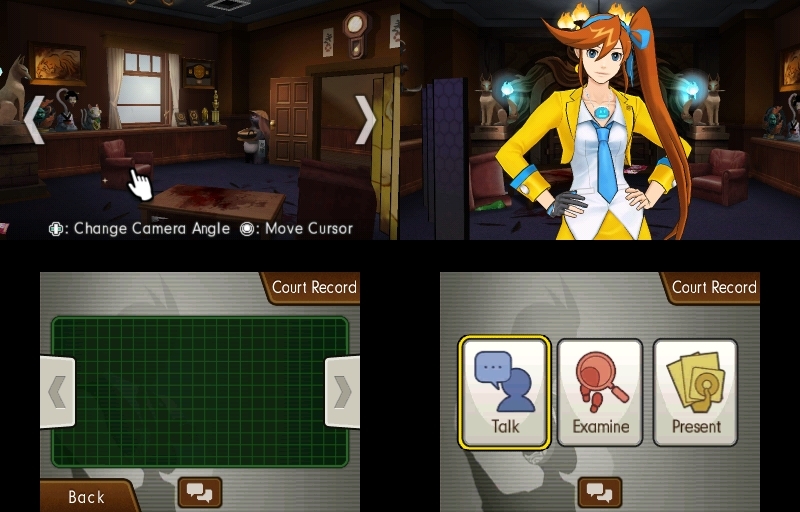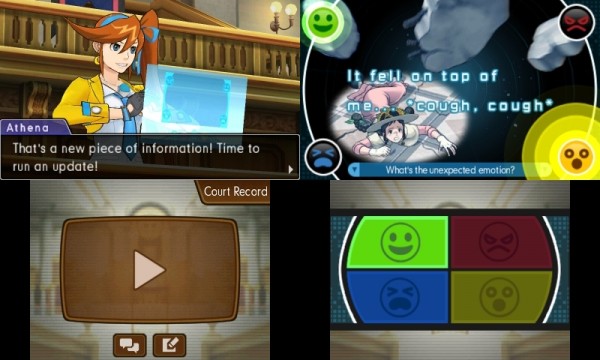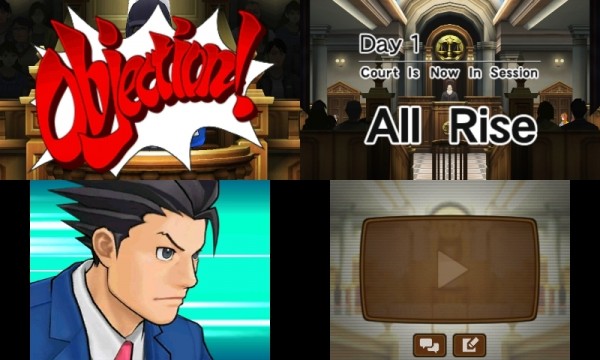Superb production values; consistent art direction; provocative characters and plot; controlled fanservice
Inconsistent voice acting; excessively telegraphed solutions; sometimes melodramatic
Phoenix Wright has returned.
On the Nintendo DS, the Ace Attorney games served as excellent introductions to the Japanese visual novel (and the adventure genre in general), with their unforgettable cast, serialized plots, and thrilling courtroom drama. Despite the first three games’ beginnings on the Game Boy Advance, they held up well on the dual-screen handheld, helped immensely by the DS’s touchscreen and microphone. The former was instrumental as an interface for investigation and navigation, and the latter allowed players to shout “Objection!” with abandon like any self-respecting lawyer should.
The first four Ace Attorney titles are bastions in the Nintendo DS library, and rightfully so. Bearing testimony to its pedigree, Phoenix Wright: Ace Attorney – Dual Destinies carries the torch with aplomb.
Set in the year following the events of Apollo Justice, Dual Destinies sees Phoenix Wright restored to top billing after being readmitted to the bar. Despite the title change, Phoenix isn’t the only playable character— fellow defense lawyer Apollo continues to play a major role after debuting in the last game, and new assistant-cum-attorney debutante Athena Cykes is a worthy addition to the Wright Bat-family.
For the series’s premiere on 3DS, Capcom used its MT Framework Mobile engine, which has proven its graphical prowess in Super Street Fighter IV, Resident Evil: Revelations, and Monster Hunter 3 Ultimate. The transition from sprites to polygonal artwork in beloved franchises has been hit (Professor Layton and the Miracle Mask, Pokémon X and Y) or miss (pretty much anything on Nintendo 64). I was astounded to see how accurate the shift has been for the Ace Attorney cast– the body language of the returning characters is identical to their original sprite art, with new tells thrown in for good measure. The dramatic frame-by-frame shifts in animation return, which helps greatly in setting the tone for the art direction. Stereoscopy is used to great effect, from hand-drawn cutscenes, environmental dioramas viewable from various angles, and dynamic finishing poses.

The audio in the game has also benefited from the generational leap. All members of the court get revamped Chords of Steel with new voice clips, and while the voice acting in the fully animated cutscenes is iffy at times, their in-game soundbites are as energetic as ever. Numerous classic tracks have been rerecorded with a mix of physical and digital instruments, including the signature songs of Phoenix Wright (heroic to the end), Apollo Justice (with a phenomenal piano version heard in the field), and Trucy Wright (which was butchered, but still). Original compositions for the game, such as cross-examination, investigation, and Athena’s theme work together with the new art to deliver a rousing return to the Ace Attorney universe.
This combination of old and new is evident in the gameplay mechanics as well. Courtroom duels with the prosecution return, involving cross-examinations, presentation of facts, and much yelling, gallery murmuring, and gavel banging. Athena brings the examination of emotions to the bench, complementing Phoenix’s magatama and Apollo’s bracelet in its ability to tear apart witness statements.

The widely-maligned investigation phases have been streamlined, with a Notes tab joining Profiles and Evidence during investigations to ensure that one never gets lost or stuck. Plus, only locations pertinent to the case at hand are examinable, further facilitating the process. This might be a boon to those who often hit walls during the detective phase of the game, but the flavor text and banter during meaningless investigation is a loss for fans who poke at every point of interest (and answer questions incorrectly) to uncover every bit of dialogue.
And for the fans this game is. Wisely, recurring NPCs are used sparingly but effectively, but references to past trials, characters, and in-jokes abound, including the series standby about a manner of vertical conveyance (to step or not to step?). Ace Attorney is one of those series that gets better with each successive game, simply because its quality has not flagged. Each game builds up on what came before it, allowing us to experience the life and world of Phoenix Wright. Therefore, even though Dual Destinies is the best game in the franchise, this quality is informed by and presupposes our familiarity with the people and the ridiculous society that they inhabit.

Dual Destinies features the most cohesive story in the entire series, with each subsequent case sustaining the overarching narrative. After an explosive opening sequence, much of the game focuses on the origins of the current state of affairs, the changes in the two returning attorneys, and the motivations for Athena Cykes and Simon Blackquill, the new prosecutor. Relevant new themes are explored, revolutionary characters are introduced, and that unprecedented M rating is earned, but not squandered. For those who disliked Apollo Justice, Dual Destinies even manages to bridge the seven-year gap that preceded the DS game, tie up loose ends, and establish a new paradigm for the future of the series.
Such high praise does not preclude Dual Destinies from its flaws. Questionable moments in the already (lovably) convoluted plots strain the suspension of disbelief, with certain items of evidence and character choices contradicting the established means of murder. Whereas previous Ace Attorney games were criticized for having the most obtuse solutions, Dual Destinies is a bit too eager to tell players what to do next, often leaving no room for solving the problem. A new Hotel Dusk-like system where one of the three attorneys pieces things together has plenty of visual flair, but doesn’t reveal anything not easily deducible. However, the game’s myriad improvements overrule these minimal oversights.

Phoenix Wright: Ace Attorney – Dual Destinies is a masterpiece that raises the bar for the series, employing all of its strengths and eliminating the vast majority of its weaknesses. This fifth mainline entry pays homage to its heritage while paving the way for the franchise going forward. Here’s hoping that the next turnabout doesn’t come with another six-year wait.
Nintendojo was provided a copy of this game for review by a third party, though that does not affect our recommendation. For every review, Nintendojo uses a standard criteria.




 ShareThis
ShareThis







I can’t agree with you more on this review. I think it’s also worth noting that investigations, while streamlined, are ridiculously linear. It’s never really a challenge to figure out where to go, and the game even puts you in places you need to be at times. It kind of made the notebook pointless for me. I also miss being stopped by psyche-locks in investigations and knowing I would have to come back later to break them, since it added a layer of thought to investigations.
Haha, it sounds like I’m complaining, but I actually love this game a lot. It’s definitely the best Ace Attorney since Trials and Tribulations. Great Review!